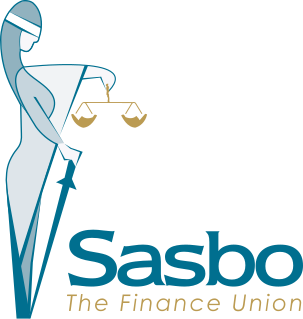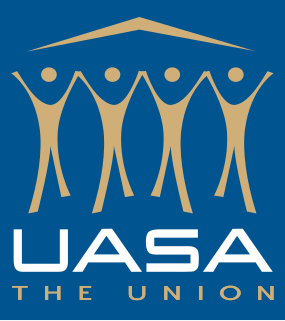Related Research Articles

SASBO – The Finance Union is a trade union in South Africa. It was founded in 1916 and has a membership of 70,000.

The UASA is a general union in South Africa.
The South African Trades Union Congress (TUC) was a national trade union federation in South Africa.
Die Spoorbond was an Afrikaner railway trade-union formed in 1934 by H. J. Klopper, founder of the Afrikaner Broederbond, which advocated a policy of replacing all black railway-workers with Afrikaners. It rejected strikes and called instead for loyal service to the South African Railways and Harbours Administration (SARHA). The union had a membership of some 16,000 in the 1930s, considerably more than that of its rival, the National Union of Railway and Harbour Servants, which was forced to dissolve in 1937.
The Amalgamated Engineering Union of South Africa (AEU) was a trade union representing white manufacturing workers in South Africa.
The South African Confederation of Labour (SACOL) was a national trade union federation of white workers in South Africa.
The Federation of South African Labour Unions (FEDSAL) was a national trade union federation in South Africa.
The Underground Officials' Association (UOA) was a trade union representing supervisors in the mining industry in South Africa.
The Motor Industry Staff Association (MISA) is a trade union representing workers in the motor industry in South Africa.
The Artisan Staff Association (ASA) was a trade union representing higher-paid technical railway workers in South Africa.
The United Transport and Allied Trade Union (UTATU) was a trade union representing workers in the transport industry in South Africa.
The South African Iron and Steel Trades Association was a trade union representing white metalworkers in South Africa.
The South African Footplate Staff Association (SAFSA) was a trade union representing white railway workers in South Africa.
The Federal Consultative Council of South African Railways and Harbours Staff Associations (FCC) was a national trade union federation bringing together unions representing white railway workers in South Africa.
The Sweet Workers' Union (SWU) was a small but long-lived union representing confectionery workers in South Africa.
The South African Reduction Workers' Association (SARWA) was a trade union representing officials involved in processing mining ores in South Africa.
The South African Equity Workers' Association (SAEWA) is a general union in South Africa.
The Hospitality Industry and Allied Workers' Union (HIAWU) is a trade union representing workers in the hospitality sector in South Africa.
The South African Railways and Harbours Employees' Union (SAR&HEU) was a trade union representing lower-paid white workers on the railways in South Africa.
The Motor Industry Employees' Union was a trade union representing workers involved in vehicle building in South Africa.
References
- ↑ Lewis, Jon (1984). Industrialisation and Trade Union Organization in South Africa, 1924-1955. Cambridge: Cambridge University Press. ISBN 9780521263122.
- ↑ Miller, Shirley (1982). Trade Unions in South Africa 1970-1980: a directory and statistics. Cape Town: Southern Africa Labour and Development Research Unit. ISBN 0799204692.
- ↑ Von Holdt, Karl (May 1993). "In the number 2 spot" (PDF). South African Labour Journal. 17 (3). Retrieved 25 March 2021.
- ↑ "FEDUSA: Working for the nation" (PDF). South African History Online. Retrieved 25 March 2021.
- ↑ Mantashe, Gwede (2008). The decline of the mining industry and the response of the mining unions. Johannesburg: University of the Witwatersrand.